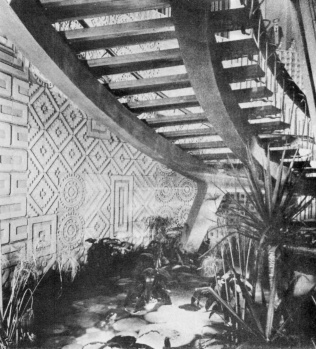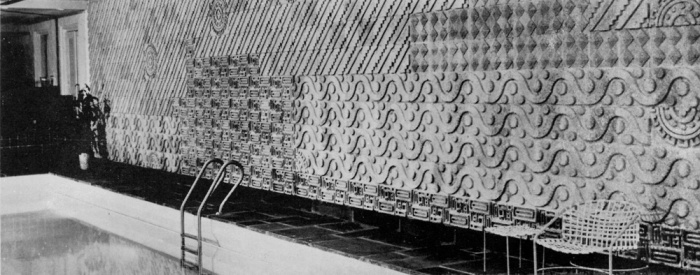In his editorial for the November 1963 issue of Mississippi Architect, Bob Henry sets forth a little history of the architectural profession in Mississippi, not only showing the increasing professionalization of the state’s architects but the large numerical growth after World War II.
Several of the national/stock articles in the same issue demonstrate tangibly the newfound confidence (some might say overconfidence) of the architectural profession. One article in particular that caught my eye was about the new ways of using cast concrete to spice up wall surfaces with all sorts of interesting textures. This is the material that is used throughout the Gulfport Library and to vivid effect, in my opinion. The library was begun in 1964, only a few months after this article, so who knows, maybe the architect, Charles L. Proffer, saw this article and found his inspiration?
—————————————
WE BUILD WITH CONFIDENCE
Prior to World War II there were only twenty- three architectural firms located in nine communities in the whole state of Mississippi. In the average community, the architect’s activity was confined to the design of churches, schools, and hospitals. Few people knew him and still fewer had any idea of what he did other than “drawing blueprints.” The situation has changed.
Since World War II many young architects have looked elsewhere and concluded that Mississippi offered almost unlimited challenge and opportunity. Seventy-four architectural firms are now located in twenty-four communities, large and small, from the Tennessee line to the Gulf coast. Correspondingly, more people know more about architecture and architects. Hundreds of buildings are now constructed with the benefit of architectural services that, twenty-five years ago, would have been built from a rough sketch on the back of a brown envelope.
The architectural profession believes in the future of Mississippi. We believe that the potential for economic and cultural development is unlimited and that architecture will necessarily be a vital facet of that development. We look forward to an increasing appreciation for good architecture on the part of all Mississippians. If this is to be so, we must produce good architecture.
We dedicate ourselves to that task.
-Bob Henry
——————————————
Cast Concrete Transformed Into Modules Of Design For Building Ornamentation

Full wall of sculptured stone gives stunning impact to lobby of famous Americana Hotel in Miami Beach. The designs are authentic adaptations of stone carvings from ancient Mexican cultures.
CAST CONCRETE is now cast in a new role as a highly sophisticated and flexible art form for building ornamentation.
Arts for Architecture, Inc., has adapted this material into three-dimensional squares of sculptured designs which can be joined together to create sculptured wall facings for exterior and interior building walls.
Each square is a different design but all utilize a basic 12″ x 12″ module. This makes it possible for architects and designers to interrelate, arrange and rearrange these modules to create wall facings of their own patterns and to any height and length desired.
The designs are inspired by stone carvings of ancient Yucatan, Mayan, Gothic and South Seas origin. James Seeman, president of Arts for Architecture, Inc., who is both artist and engineer, united these talents to adapt the basic design elements of the ancient stone sculptures within modern-day modular concept.
Special paper patterns are made available for architects and designers who can then shift them about, much like cutouts, to work out their own arrangements.
In the lobby of the famous Americana Hotel in Miami Beach, the use of an Arts for Architecture wall in Mayan and Aztec designs, achieves stunning effect in this important public area. And in New York and elsewhere, sculptured walls appear as facades across the entire exteriors of office buildings.

Indoor swimming pool enhanced into unusual originality and elegence with a sweeping wall of sculptured stone. Blocks may be arranged and interrelated in unlimited choice of pattern designs.
In addition to his own design creations, James Seeman also commissions outstanding artists of the world.
For example, “Taniko,” a stone mural consisting of individually designed squares whose inspiration derives from the art of the South Sea Islands, is the work of Mr. Perli Pelzig, internationally known artist. Among other honors, Mr. Pelzig holds the American Institute of Architects Gold Medal.
“Sculptured walls,” notes Mr. Seeman, “have been a major art expression in every highly civilized society and, in fact, are an essential complement to the general austerity of contemporary architecture and design.”
————————————-
This article is reprinted from the November 1963 issue of the Mississippi Architect, with permission from the Mississippi Chapter of the American Institute of Architects. View the full November 1963 issue of Mississippi Architect in a digitized format, or for other articles in this ongoing series, including the pdf version of each full issue, click on the MSArcht tab at the top of this page.
Categories: Architectural Research

Very interesting! Thanks for the information!
LikeLike